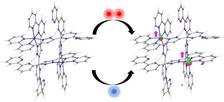The researchers used infrared light to change the spin states of two iron ions in the molecule (Credit: DESY)
A family of molecules known to take in the rays and flex – fitting, then, that this summer, an international team using the pulsed properties of ultrafast optical lasers and synchrotron light sources like PETRA III at DESY could publish new findings about them. This family of molecules, which are inexpensive to synthesise, are thought to be good candidates for being transfer units of quantum information. The molecules were already known to change their shape when exposed to visible light. The team extended their knowledge of the compounds by replicating their behaviour in infrared light, the form of light used in fibre optics and thus in application. The results, which further extend the possibility of using these molecules in quantum technologies, are published in the Royal Society of Chemistry journal Chemical Science.
Quantum information is an inherent property of elementary particles. This information is presented through a variety of characteristics of the particle, including the direction of a particle’s spin. These characteristics can be transferred to other particles. The molecule used in this experiment is a synthetic, light sensitive compound based around a ring of two iron ions and four organic ligands. The iron ions are normally in what is known as a low-spin state. When the ions receive spin information from another particle – such as a particle of light or photon – they could change to a high-spin state. The conversion from low- to high-spin state causes a large organic section of the molecule bonded to the ion to move. This motion is the product of the translation of the quantum information, which means it can work as a sort of detailed molecular switch – potentially a very useful component.
“The molecule is, from a materials point of view, very inexpensive – it’s about as cheap as plastic,” says the lead author of the study, DESY lead scientist and University of Göttingen professor Simone Techert. “We knew that it responded to visible light, but no one had confirmed that it could also respond to infrared light – it was still a completely open question.” Infrared light is important because in quantum technologies, infrared light pulsed through fibre optics is used. This however raised an issue: Visible light is more energetic than infrared light, meaning more infrared photons would be needed to initiate the same effect in the molecule’s iron ions. “There was a danger in the higher-intensity infrared light damaging the molecule,” Techert says.
Techert and the team used the PETRA III light source and an infrared laser to examine the molecule’s response in detail. Using spectroscopy, the team could monitor the absorption of two photons in the iron ion and the resulting movement of the ligand. “The iron grid works like a circuit in the molecule, in that the iron ions ‘talk’ through their spin,” says first author Jose Velazquez-Garcia, a postdoc in Techert’s group at DESY. And it’s a specific exchange of quantum information which gets altered by the incoming light, meaning that many different signals might be possible coming out of the molecule – not just an on-off switch or even a four-way switch based on the iron ions but rather a signal far more complex and nuanced. Next tests will further analyse these quantum effects and make the surroundings even more like in an application situation.
“We’ve shown that this molecule can practicably transfer quantum information,” says Techert. “Some clever people could one day come along who can make it into some part of a quantum computer, I’m sure.”
The team comprised researchers from DESY, University of Göttingen and its Collaborative Research Center CRC1073 “Atomic Scale Control of Energy Conversion”, Universität Hamburg and its Cluster of Excellence “CUI – Advanced Imaging of Matter” as well as Universität Potsdam in Germany and Argonne National Laboratory in the US.
(from DESY News)
Reference:
“Out-of-equilibrium dynamics of a grid-like Fe(II )spin crossover dimer triggered by a two-photon excitation”, Jose de Jesus Velazquez-Garcia, Krishnayan Basuroy, Joanne Wong, Serhiy Demeshko, Franc Meyer, Insik Kim, Robert Henning, Yannic U. Staechelin, Holger Lange, and Simone Techert, Chemical Science (2024), DOI: 10.1039/d4sc02933j







